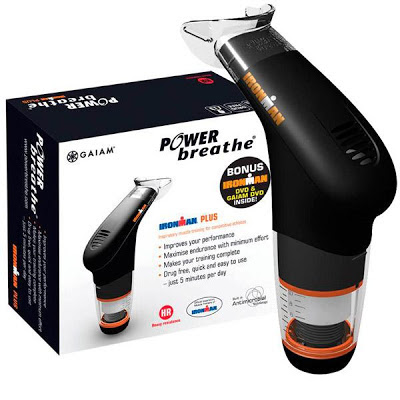Back in the days when I was even more obsessed with training than I am now, I bought one of these:
Actually, now I come to think of it, watching the free DVD that came with it was the first time I had ever heard of an Ironman. Little was I to know then, that I would be bitten by that bug. Needless to say, I have barely used this gadget since I bought it.
As Alison McConnell (inventor of Powerbreathe) says in her book, "Breathe Stronger - Perform Better", this is an example of where common sense prevails over science in that common wisdom has it that breathing limits our performance (unlike, for example, the idea that doing stomach crunches somehow "burns" abdominal fat). Science for a long time has maintained that there is no performance benefit to be gained from breathing training, based on the fact that our blood (at sea level, at any rate) is always at least 99% oxidized.
Alison argues that, while it may not be possible to increase oxidation of the blood, the breathing muscles themselves can be trained to better resist fatigue - again, contrary to the scientific assumption that the breathing muscles, unlike any other muscles in our body, are somehow super-evolved or super-trained to never fatigue. Specific tests show otherwise and, it turns out, that it is more critical to train the inspiratory (not inspirational) breathing muscles than the expiratory ones. This is because the inspiratory muscles must work harder as the lungs expand, while the expiratory muscles benefit from elasticity (and, to some extent, gravity) so the inspiratory muscles will always be the first to fatigue. Training these muscles has been shown to delay fatigue and even increase depth of breathing but, interestingly, attempts to train both inspiratory and expiratory muscles in the same breath cycle have had little or no impact on either, perhaps due to the added difficulty associated with performing the exercise. The reason she offers to explain why these muscles are not sufficiently trained as a by product of functional training is that the stresses are only enough to stimulate an adaptation at the end of a race or maximal effort which is for too short an amount of time to really have an effect.
The next question she tackles is whether breathing muscle fatigue affects performance in sports. Firstly, of course, there is the obvious idea that we feel discomfort with breathlessness and tend to slow down as a result. But what I found extraordinary is that recent studies have demonstrated something called the metaboreflex which is a reduction in the volume of blood to the limbs caused by breathing muscle fatigue! It seems that evolution has built in a physiological mechanism to slow us down, perhaps to avoid catastrophic failure in the breathing muscles. A third consideration is that the breathing muscles are not only used for breathing but also for core stability and, in some cases such as rowing, they even contribute to the propulsion itself (by the stiffening of the trunk). While the expiratory muscles are often well trained by those wanting to have a "six-pack", the inspiratory muscles are overlooked.
The training itself involves setting the Powerbreathe device such that you can only just manage to complete 30 breaths. These breaths should be as fast and as deep as possible (as the rib cage and lungs expand, the force required increases) and let out slowly. I had to start on 1.5 (out of 10!!) on my device (which is level 3) and am now on about 2 after a week or so. The scientific studies show an improvement of 2-4% in speed in a time trial versus 20%-50% increase in time to failure across a number of sports (running, cycling, swimming and rowing) after as little as 4 weeks of 30 breaths, twice a day. Arguably, the best benefit should be seen in swimming where there is no option to breath with a higher cadence when more oxygen is required and the depth of breathing is much more significant.
I'm not sure whether I will really notice a benefit but the book is certainly convincing. I haven't seen many people talking about using Powerbreathe but the science behind it is relatively new and has yet to penetrate the public domain (although there is, predictably, already an iPhone App available!). If it just helps me in those final few hundred metres of a race when I have sometimes started to wheeze out of breathlessness, then that is good enough for me. It is a relatively small investment both in terms of price (around 50 pounds) and time (6 minutes a day). I'll let you know if I manage to get much higher on the scale of 1-10!



No comments:
Post a Comment